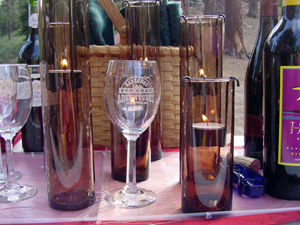Extra Fuel Cans Are A Real Gas
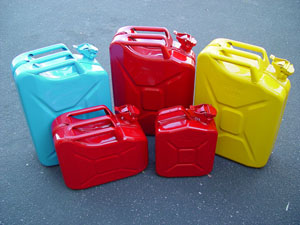 One well-known model is the "jerry" can (sometimes called NATO style).
One well-known model is the "jerry" can (sometimes called NATO style).
(Click picture for a larger image.)
|
Due to a number of variables, it’s difficult to say precisely how much extra gas you need for a particular trip.
Generally, 5 to 10 gallons is enough for most trips. That will get you to another source of fuel in most circumstances.
One factor is your vehicle’s mileage while off road. As a newer driver, you’re not likely to know that.
Your first few trips should be on shorter routes close to civilization.
These give you the chance to measure the difference in fuel consumption of your vehicle off-road. (And, of course, build some skills.)
Sizes, styles of gas cans
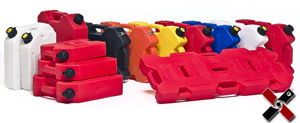 RotopaX cans are rectangular and feature hand holds and openings that allow you to mount them in a variety of ways.
RotopaX cans are rectangular and feature hand holds and openings that allow you to mount them in a variety of ways.
(Click picture for a larger image.)
|
You have several styles and brands to choose from. In most cases, the style is dictated by how you plan to mount the gas can.
One well-known model is the "jerry" can (sometimes called NATO style). Wedco and Wavian make this type, in steel.
The most common size is 20 liters, which easily holds 5 gallons. (Incidentally, the 5-liter just the right size for holding wine! But probably not food grade.)
The "jerry" can has been around since WWII. An important feature is the special cap.
Note that it clasps securely, thereby eliminating leakage while you’re bouncing along on the trails.
The cans must now be sold with a unique funnel. With that special funnel the gas can is CARB compliant. CARB stands for California Air Resource Board.
Look for the “CARB Compliant” label on all gas cans and spouts, even if you live in other states. The EPA has adopted the CARB requirement.
RotopaX cans are rectangular and feature hand holds and openings that allow you to mount them in a variety of ways.
They come in smaller sizes than the Wedco cans, too. The 2 gallon version is very popular. The cans can be stacked together for easy transport.
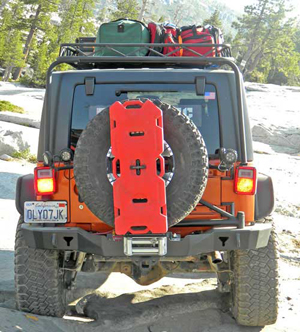 A RotopaX on a vehicle from www.Olympic4x4products.com
A RotopaX on a vehicle from www.Olympic4x4products.com
(Click picture for a larger image.)
|
Cam Cans , by Day Star, are designed to mount on the inside of the spare tire with the hardware provided.
They are available in convenient 2-gallon versions.
When you are first setting up your rig and need a quick solution, before you have had time to add tire racks and roof racks, look at the Cam Cans.
Another option is the fuel caddy by AEV. This is designed to mount between the spare tire and tail gate. A nifty arrangement, and at 10 gallons,
it has a lot of capacity.
The caddy is quite heavy with that amount of gas, so it stays mounted while you refuel.
You’ll want to use something like a Super Siphon, described below, to transfer the gas to your tank.
You may have heard of or seen a Sceptor gas can. These are similar to jerry cans made of heavy plastic.
They don’t have the CARB compliant cap and cannot be sold legally in the U.S. They are only available to the US military and Homeland Security.
A final option is to install another gas tank. That’s an expensive route, although a very nice solution for long range overlanding.
Make sure the gas tank is installed properly and that your vehicle still meets air quality standards; that is your vehicle will still pass the Smog test.
You don’t always need that much extra gas while four wheeling, though. Four to ten gallons is usually plenty.
How to mount the gas can
 Gas cans can also be transported on the top of your vehicle. This image shows six jerry gas cans on a roof rack.
Gas cans can also be transported on the top of your vehicle. This image shows six jerry gas cans on a roof rack.
(Click picture for a larger image.)
|
The most common method involves mounting on an after-market bumper.
Most replacement bumpers are designed to accommodate the spare tire and at least one 5 gallon gas can - many come with two slots for cans.
RotopaX cans and AEV’s fuel caddy, as mentioned above, mount nicely to the spare wheel assembly. (Some extra hardware may be needed.)
Gas cans may also be transported on the top of your vehicle. The image shows six jerry gas cans on a roof rack. By far the largest drawback to roof top
storage is lifting the cans into place.
As a rule of thumb, you can assume Gas weighs about 6 pounds per gallon (depending on the blend and additives it can be a bit more or less).
So a full 5 gallon can of gas is in the neighborhood of 30 pounds. Not too bad, until you have it overhead.
By the way, a gallon of water is 8.3 pounds,
which explains why a 5 gallon can of water at 41.5 pounds is so much harder to lift onto the roof rack.
Also you should use these calculations to determine the load you are placing on the roof rack.
Six can at 30 pounds is 180 pounds which might actually exceed the rated capability!
I have a backup plan for the day, I feel too weak to muscle a gas of can onto the roof rack.
I strategically placed the gas cans behind the sun roof so I can pop through and lift one up from the front seat!
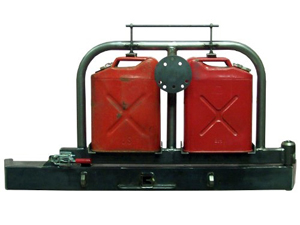 This is a TJ bumper made by www.Nates4x4.com that holds 2 cans flat behind the spare tire.
This is a TJ bumper made by www.Nates4x4.com that holds 2 cans flat behind the spare tire.
(Click picture for a larger image.)
|
How to safely fill and use gas cans
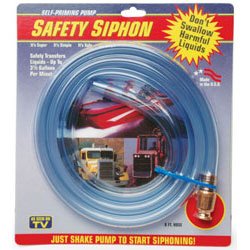 Siphoning doesn’t require you suck gas!
Siphoning doesn’t require you suck gas!
|
Safety is paramount, even when you’re filling gas cans.
Static electricity is a real concern when working with fuel. Turn off your vehicle before filling.
As you step out of your vehicle, touch some metal part of the car. Fill the gas can only when it’s on the ground.
Never smoke while filling. Turn off your engine and extinguish any flame that is nearby.
Don’t transport gasoline inside a vehicle. The fumes can build up, overpowering the occupants and creating an explosive situation.
Make sure you use the proper color of gas can for fuels: red for gasoline, yellow for diesel and (typically) green or blue for water.
The one drawback to Cam Cans is that they don’t come in red or yellow. Make sure you clearly mark which ones are used for fuel and which contain water.
Siphoning gasoline (and other fuels) used to be a challenge. Remember getting gas in your mouth? Well, times have changed.
Safety Siphon and Super Jiggler have developed a nifty siphon that doesn’t require you to suck the gas.
The siphon is simply a clear piece of plastic tube with a special brass valve on one end.
After inserting the brass end in the source of fuel, you jiggle it a few times. That will get the fuel flowing. It’s like magic!
Both brands are relatively inexpensive, and they’ll drain a gas can in minutes. These siphons rely on gravity flow, so the gas can should be above the gas tank inlet.
Funnels work in a pinch but be careful to minimize spillage.
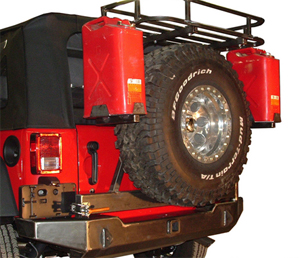 A typical way 2 cans are mounted on either side of the spare.
A typical way 2 cans are mounted on either side of the spare.
(Click picture for a larger image.)
|
If you plan to store your gas for at least a month, add fuel stabilizer (STA-BIL or Motor Medic) to the fuel.
Typical mix is 2 oz. for every 5 gallons of gas. Manufacturers claim it’ll last up to 1 year. I’ve had gas remain in good condition for upwards of 18 months.
Carrying extra gas is important for every 4WD trip.
Use this information to help you determine which type and size(s) of gas cans are best for your vehicle and driving.
You can then go four wheeling confident that you have some spare gas if your tank runs low.
##########################
Related Articles from Badlands Off-road Adventures
|
Did you miss the previous article?
Some Upcoming Events
(click on the link for details)

Mojave Lower Desert, CA
(Click picture for a larger image.)
|
Summary of upcoming events.
|
##########################
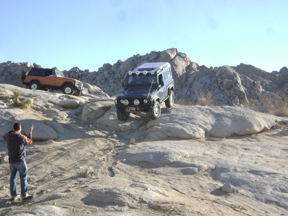
Rocks
|
The Class will be in Johnson Valley. This is an introduction to Rock crawling but it is not on "baby" rocks.
We take our time and stress careful wheel placement.
We use spotters for difficult sections. You learn by inspecting the obstacle and predicting the line; by watching others try their line;
by experiencing it yourself; and by the coaching. We recommend you repeat the training several times.
You will be much more relaxed the second time over the same obstacles and you will pick up on little details missed the first time.
More Details...
You can register directly at
http://www.4x4training.com/calendar/calendar.php#Rocks
|
##########################
Wine Safari July 25
We have two big events coming up during July and August - The Wine Safari and the Rubicon Trail. It is time to register for both
events. The Wine Safari is only a few weekends away and you need to start planning for the Rubicon Trail (see below).
Don't miss the Wine Safari. Click here for all details.
Our Wine Master will have a whole new bunch of bottles and some old favorites to taste. Make it a get-away weekend.
Camp with us or stay in a local motel.
Register now.
http://4x4training.com/calendar/calendar.php#wine.
|
##########################
Rubicon Trail Adventure August 10- 13, 2015
The Rubicon Trail is the stuff of legends.
It is considered the Grand Daddy of trails.
If your vehicle has a weakness, it will find it. Any serious four-wheeler needs to "Do the 'Con" at least once.
There is no guarantee of avoiding vehicle damage.
Even the most skilled driver can succumb to the fatigue of 12 unrelenting miles of rocks.
Just bring a good attitude and the best prepared vehicle you can.
This could be a once in a lifetime trip but a lifelong of bragging rights.
More Details
You need to register now so you have time to prepare. Register directly at
http://4x4training.com/calendar/calendar.php#Rubicon
|
Winch Recovery Bandana & Winching DVD
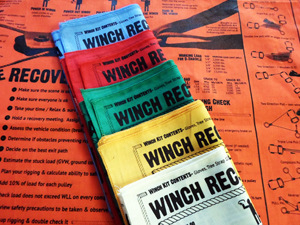
Click for higher resolution image
|
We have our new stock with many new colors (Red, Orange, Green, and Blue) on hand.
The Bandana is packed full of useful information and is a quick reference in the field when no DVD player is available."
The Bandana layout follows the “Vehicle Recovery Plan” with pathways to more detail.
A unique section of the Bandana, gives the steps for a “Winch Rigging Check: Walk through” so that you verify every element of the rigging before you commit to the pull.
Stuff this in your recovery kit and you will always be ready!
Pick up or order the Winching DVD too!
There is no substitute for hands on training. If you can, sign up for one of Badlands Off-Road Adventure’s Winching Clinics.
Warning – the Bandana and DVD are not a substitute for proper training and use of quality equipment that is used within the bounds of their safe working load.
We advise you to use the information provided in both the Winching Recovery Bandana and the "Basic to Advanced Winching and Recovery DVD" at your own risk.
We cannot control the quality and specifications of the equipment used and the methods actually employed.
|
Winch Recovery Bandana Order Button
|
Order a Basic to Advanced Winching & Recovery DVD too!
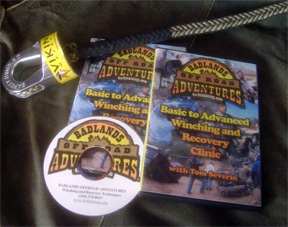
(Click picture for more details)
|
|
I hope to see you on the trails!
Tom Severin, President
Badlands Off Road Adventures, Inc.
4-Wheel Drive School
310-613-5473
http://www.4x4training.com
Make it Fun. Keep it Safe.
#####
If you find this information valuable, please pass it on to a friend. You can forward them the email.
If you received a forwarded copy of this newsletter and would like to subscribe for yourself, go to:
www.4x4training.com/contacts.html
and follow the instructions to join our mail list.
Want To Use This Article In Your Magazine, E-Zine, Club Newsletter Or Web Site?
You are welcome to use it anytime, just be sure to include the following author/copyright information:
Tom Severin, 4x4 Coach, teaches 4WD owners how to confidently and safely use their vehicles to the fullest extent in difficult
terrain and adverse driving conditions.
Visit www.4x4training.com to develop or improve your driving skill.
Copyright 2015, Badlands Off-Road Adventures, Inc.
|
|
 One well-known model is the "jerry" can (sometimes called NATO style).
One well-known model is the "jerry" can (sometimes called NATO style).
 RotopaX cans are rectangular and feature hand holds and openings that allow you to mount them in a variety of ways.
RotopaX cans are rectangular and feature hand holds and openings that allow you to mount them in a variety of ways.
 A RotopaX on a vehicle from www.Olympic4x4products.com
A RotopaX on a vehicle from www.Olympic4x4products.com
 Gas cans can also be transported on the top of your vehicle. This image shows six jerry gas cans on a roof rack.
Gas cans can also be transported on the top of your vehicle. This image shows six jerry gas cans on a roof rack.
 This is a TJ bumper made by www.Nates4x4.com that holds 2 cans flat behind the spare tire.
This is a TJ bumper made by www.Nates4x4.com that holds 2 cans flat behind the spare tire.
 Siphoning doesn’t require you suck gas!
Siphoning doesn’t require you suck gas!
 A typical way 2 cans are mounted on either side of the spare.
A typical way 2 cans are mounted on either side of the spare.


